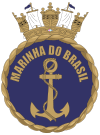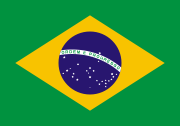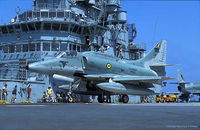Brazilian Navy
| Brazilian Navy Marinha do Brasil |
|
|---|---|
 Brazilian Navy Seal |
|
| Active | 1822 - today |
| Country | |
| Branch | Navy |
| Type | Navy |
| Size | 60,000 active personnel[1] 99 ships, 89 aircraft |
| Part of | Ministry of Defence Navy Command |
| Headquarters | Brasília/DF |
| Patron | Marquis of Tamandaré |
| Colors | Blue & White |
| March | Cisne Branco |
| Engagements |
War of Independence
Argentina-Brazil War War of Tatters War of the Triple Alliance World War I World War II |
| Commanders | |
| Commander-in-Chief | Luiz Inácio Lula da Silva |
| Navy Commander | Admiral Júlio Soares de Moura Neto |
| Insignia | |
| Naval Ensign[2] |  |
| Naval Jack |  |
| Aircraft flown | |
| Attack | A-4 Skyhawk |
| Helicopter | SH-3 Sea King, AS-332 Super Puma, Super Lynx, Esquilo, Bell Jet Ranger, SH-60 Seahawk |
The Brazilian Navy (Portuguese: Marinha do Brasil) is a branch of the Brazilian Armed Forces responsible for conducting naval operations. It is the largest navy in Latin America.[3] It is equipped with a 32,800-ton aircraft carrier, the NAe São Paulo (formerly Foch of the French Navy), British-built frigates, locally-built corvettes, coastal diesel-electric submarines and many other river and coastal patrol craft, among other vehicles.
Contents |
As of 2009, the Brazilian Navy consists of 60,000 active personnel[4], 99 ships in commission[5] and 89 aircraft[6]. The current Navy Commander is Admiral Júlio Soares de Moura Neto[7].
Hierarchy
The main branches of the Brazilian Navy are:[8]
- The "Comando de Operações Navais" (Naval Operations Command)
-
- The "Comando da Força de Superfície" (Surface Fleet Command)
- The "Comando da Força de Submarinos" (Submarine Fleet Command)
- The "Comando da Força Aeronaval" (Naval Aviation Command)
- The "Comando da 1ª Divisão da Esquadra" (1st Fleet Division Command)
- The "Comando da 2ª Divisão da Esquadra" (2nd Fleet Division Command)
- The "Comando Geral do Corpo de Fuzileiros Navais" (Marine Corps General Command)

The Brazilian Navy has 98 ships in commission[9], and others in construction, process of acquisition, and modernization. Between 1996 and 2005 the Navy retired 21 ships.[10]
The Brazilian Navy operates one Clemenceau class aircraft carrier, the São Paulo, former French Navy Foch.
The Brazilian Navy operates four Tupi class and one Tikuna class Type 209 submarine. The Tupi class submarines will be upgraded by Lockheed Martin at a cost of $35 million.[11] The modernization includes the replacement of existing torpedoes with new MK 48 torpedoes.[12] On March 14, 2008, the Brazilian Navy purchased four Scorpène class submarines from France.[13] The Brazilian Navy is currently developing its first nuclear submarine.[14]
On August 2008 the Navy incorporated the corvette Barroso; it was designed and built in Brazil[15] at a cost of $263 million.[16]
Current major ships in commission[9]:
- 1 aircraft carrier (São Paulo)
- 5 submarines
- 9 frigates
- 5 corvettes
- 6 minehunters
- 5 amphibious ships
- 30 patrol boats
- 38 auxiliary ships
,_the_first_Brazilian_Navy_ship_to_integrate_in_a_U.S._strike_group,_steams_through_the_Atlantic_during.jpg)
Aircraft inventory

As of 2009, the Naval Aviation arm of the Navy operates 89 aircraft, with all but the A-4 Skyhawks being helicopters.

Current aircraft in service:
- 23 attack aircraft (A-4 Skyhawk)/ 12 (9 A-4 + 3 TA-4) will be upgraded (AF-1 (A-4) and AF-1A (TA-4))
- 4 attack helicopters SH-3 Sea King (SH-3)
- 12 attack helicopters Super Lynx (HA11)
- 8 (+4?) multimission helicopters SH70B Seahawk (Ordered)
- 5 transport helicopters (Eurocopter AS332) (HU14)
- 2 transport helicopters (Eurocopter AS532) (HU14)
- 18 scout helicopters (Eurocopter AS350) (HU12)
- 8 scout helicopters (Eurocopter AS355) (HU13)
- 17 training helicopters (Bell 206) (HI6)
- 8 carrier onboard delivery (C-1 Trader) (Ordered)



As of 2009, the main naval bases in use are[17]:
-
- "Base Naval Almirante Castro e Silva", submarine base
- "Base Naval do Rio de Janeiro", main naval base
- "Arsenal da Marinha do Rio de Janeiro", naval shipyard
- "Base Aérea Naval de São Pedro da Aldeia", naval aviation base
- "Base de Fuzileiros Navais da Ilha do Governador", marine corps base
- "Base de Fuzileiros Navais da Ilha das Flores", marine corps base
- "Base de Fuzileiros Navais do Rio Meriti", marine corps base
-
- "Base Naval de Aratu", naval base and repair facility
-
- "Base Naval de Natal", naval base
- "Base Naval Almirante Ary Parreiras", naval base and repair facility
- Pará:
-
- "Base Naval de Val-de-Cães", naval base and repair facility
-
- "Base Fluvial de Ladário", naval aviation base, naval base and repair facility
-
- "Estação Naval do Rio Negro", riverine naval base and repair facility
-
- "Estação Naval do Rio Grande", naval base
Mission
In addition to the roles of a traditional navy, the Brazilian Navy also carries out the role of organizing the merchant navy and other operational safety missions traditionally conducted by a coast guard. Other roles include:
- conduct of national policies vis-à-vis the sea;
- Implementing and enforcing laws and regulations with respect to the sea and inland waters.
History

When Pedro I of Brazil declared independence from Portugal in September 1822, he immediately assembled a navy that then participated in the Brazilian Declaration of Independence, which had begun a year earlier. The navy would later fight in the Cisplatine War, the River Plate conflicts, the Paraguayan War, both World War I and World War II, as well as in the sporadic rebellions that would mark Brazil's history.
In the initial decades following independence, the country had maintained a good naval establishment. Most of the Portuguese Empire's naval forces reverted overnight to the newly-independent country. In 1860 the fleet consisted of eight paddle steamers, seven screw sloops, six frigates and corvettes, and 14 smaller vessels. During the Paraguayan War, Brazil purchased several ironclads from the United Kingdom, France and from the Navy's Imperial Arsenal in Rio de Janeiro.
After the losses of the 1893 naval rebellion, there was a hiatus in the development of the navy until 1905, when Brazil acquired two of the most powerful and advanced dreadnoughts of the day. These vessels, Minas Geraes and São Paulo, were the last battleships of the Brazilian Navy. Brazil also bought two cruisers in this period, Bahia and Rio Grande do Sul.
The Brazilian Navy served in both World War I and World War II, engaging in anti-submarine warfare on the two Battles of Atlantic.
The Colossus class aircraft carrier Minas Gerais served the Navy until its decommission in 2001.
Gallery
 The Brazilian cruiser Bahia. |
 Frigate Constituição arriving in Rio de Janeiro. |
 Battleship "Minas Gerais" shooting. |
 Battleship "Minas Gerais". |
|
CTe Bauru (Be-4) |
.jpg) Destroyer D-14 "Araguaia". |
.jpg) Destroyer D-10 "Acre". |
.jpg) Brazilian aircraft carrier Minas Gerais. |
.jpg) Brazilian Navy Ship Greenhalgh (F-46) steams through the Atlantic during the Iwo Jima Expeditionary Strike Group composite unit training exercise. |
 Brazilian Super Lynx helicopter prepares to drop a boarding team by fast rope during a visit, board, search and seizure (VBSS) exercise. |
,_views_a_tactical_display_in_the_ship^rsquo,s_Combat_Information_Center.jpg) A Sailor assigned to the Brazilian Navy Niteroi-class frigate BNS Defensora (F 41), views a tactical display in the ship’s Combat Information Center during exercise UNITAS exercise. |
_enters_Mayport_Basin_during_her_first_visit_to_a_U.S._Navy_base,_sponsored_by_U.S._Naval_Forces_Southern_Command_(NAVSO).jpg) Brazilian Navy submarine Tikuna (S 34) enters Mayport Basin during a visit to a U.S. Navy base in Florida. |
 Brazilian submarine formation. |
 GRUMEC, Marine corps divers. |
 COMANF of the Brazilian Marine Corps. |
.jpg) Brazilian Frigate "Niteroi". |
,_along_with_ships_from_other_countries_participating_in_Exercise_Unitas_Gold,_takes_part_in_a_parade_of_ships_just_off_the_coast_of_Jacksonville.jpg) The Brazilian ship Constituicao (F42). |
 Rademaker(F49), a type 22 frigate of the Brazilian Navy. |
 Brazilian Navy corvette Julio de Noronha. |
 Submarino Tamoio da Classe Tupi. |
 SH-3 Sea King of Brazilian Naval Aviation. |
_during_UNITAS_exercises.jpg) Brazilian navy helicopter prepare to take off. |
.jpg) Naval ship of Brazil. |
Patrol Boat. |
.jpg) The former Royal Fleet Auxiliary Sir Bedivere, now the Brazilian Navy's Almirante Saboia, in Falmouth Docks. |
.jpg) NDCC Garcia D'Avila (G-29) |
 Patrol Boat. |
Comparison chart

See also
- Brazilian Marine Corps
- Brazilian Naval Aviation
- Brazilian Army
- Brazilian Air Force
- Military history of Brazil
- Military ranks of Brazil
- Brazil and weapons of mass destruction
References
- ↑ Comandante da Marinha confirma nova esquadra no Nordeste Marinha do Brasil. Retrieved on 2009-02-01. (Portuguese)
- ↑ Brazil uses its national flag as an ensign.
- ↑ Oceanographic and Meteorological Data Buoys Hydro International. Retrieved on 2009-06-10.
- ↑ Comandante da Marinha confirma nova esquadra no Nordeste Brazilian Navy. Retrieved on 2009-02-01. (Portuguese)
- ↑ Navios da Marinha do Brasil Brazilian Navy. Retrieved on 2009-06-10. (Portuguese)
- ↑ Asas Sobre os Mares Rudnei Cunha. Retrieved on 2009-06-10.
- ↑ Comandantes da Marinha Brazilian Navy. Retrieved on June 10, 2009. (Portuguese)
- ↑ Estrutura de Comando Defesa Brasil. Retrieved on 2009-06-10. (Portuguese)
- ↑ Uma nova agenda militar Época. Retrieved on 2008-10-09. (Portuguese)
- ↑ Brazil seeks to modernize submarine Force Mercopress. Retrieved on 2008-02-05.
- ↑ Lockheed Martin Awarded $35 Million Contract to Modernize Brazilian Navy Submarine Force CNN.com. Retrieved on 2008-02-05.
- ↑ Brazil To Start With Scorpene Strategy Page. Retrieved on 2009-06-10.
- ↑ Brazil to get nuclear sub technology from France CNN. Retrieved on 2009-06-10.
- ↑ Incorporação da Corveta Barroso Brazilian Navy. Retrieved on 2008-11-25. (Portuguese)
- ↑ Navio Mais Barato Istoé. Retrieved on 2008-08-14. (Portuguese)
- ↑ The Naval Institute Guide to Combat Fleets of the World Eric Wertheim. Published by Naval Institute Press, 2007. ISBN 159114955X, ISBN 9781591149552. Retrieved on 2009-10-06.
External links
- Brazilian Navy Official website (Portuguese)
- Poder Naval Brazilian warships and naval aviation (Portuguese)
- Global Security Brazilian Navy profile
- History of World's Navy's Ships of the Brazilian Navy
- History of VF-1 "Falcões" (Hawks) in the Brazilian Navy
- Brazilian naval flags
- Base Militar Web Magazine's Brazilian military aircraft data base
- Military Orders and Medals from Brazil (Portuguese)
- Hazegray - World Navies Today (outdated)
- Battleships
- Carriers
Videos
|
|||||